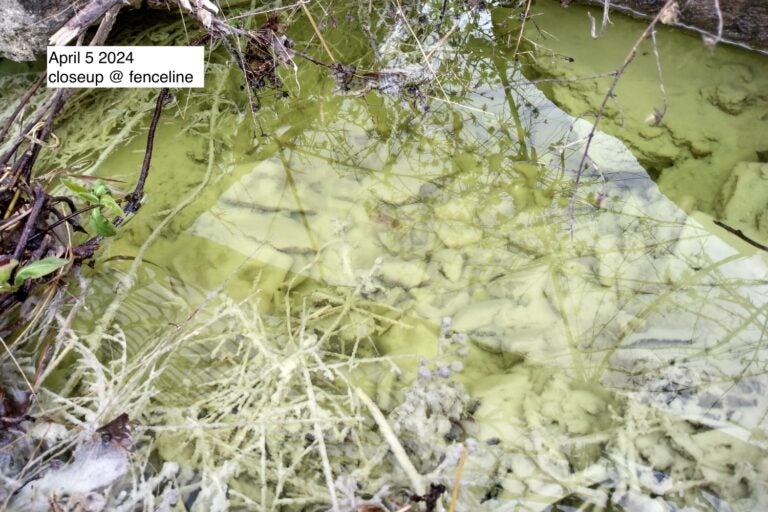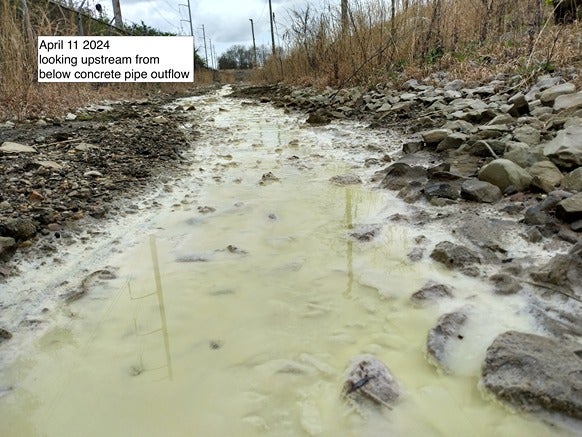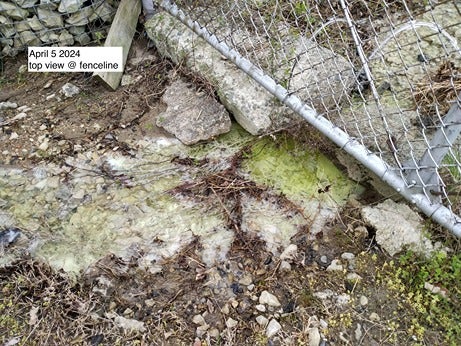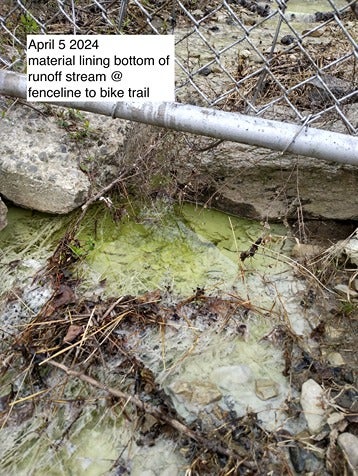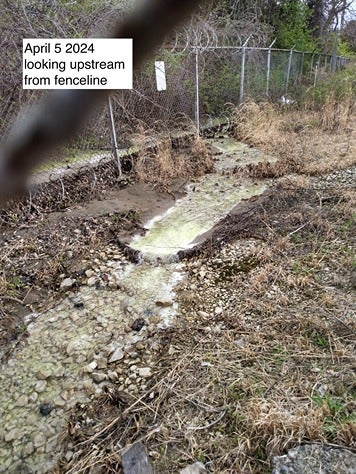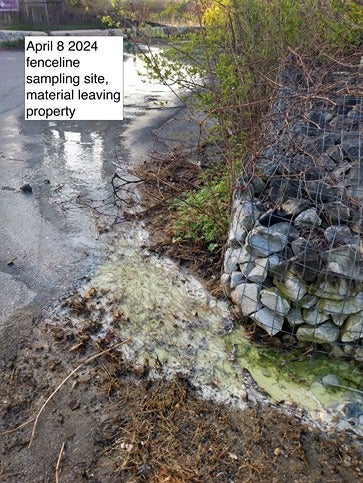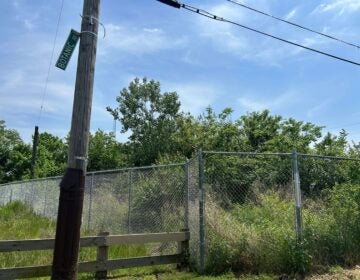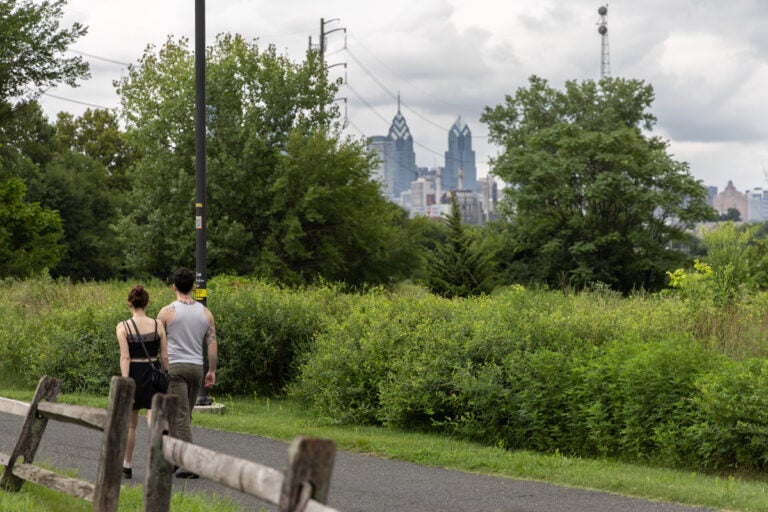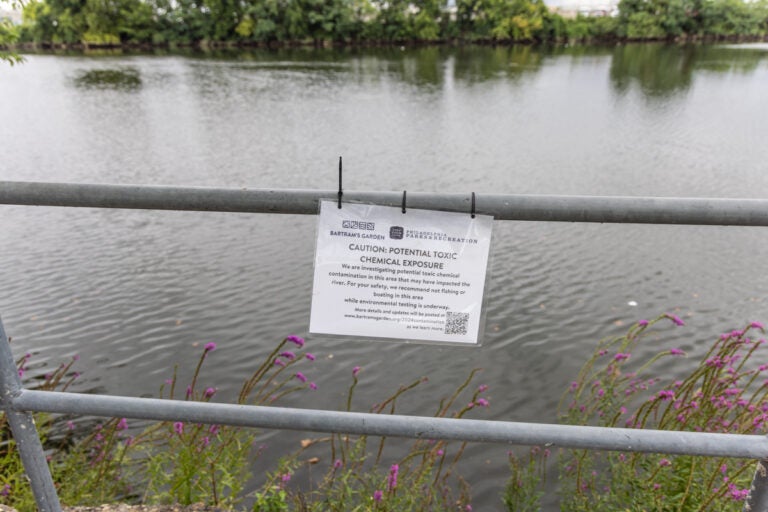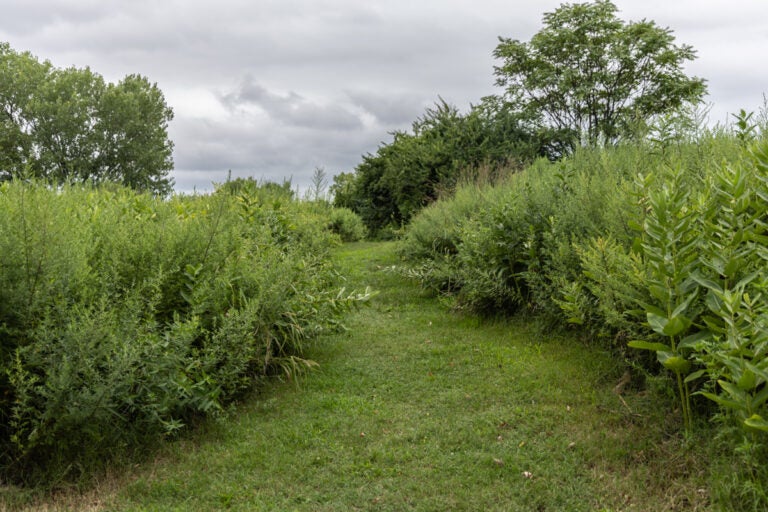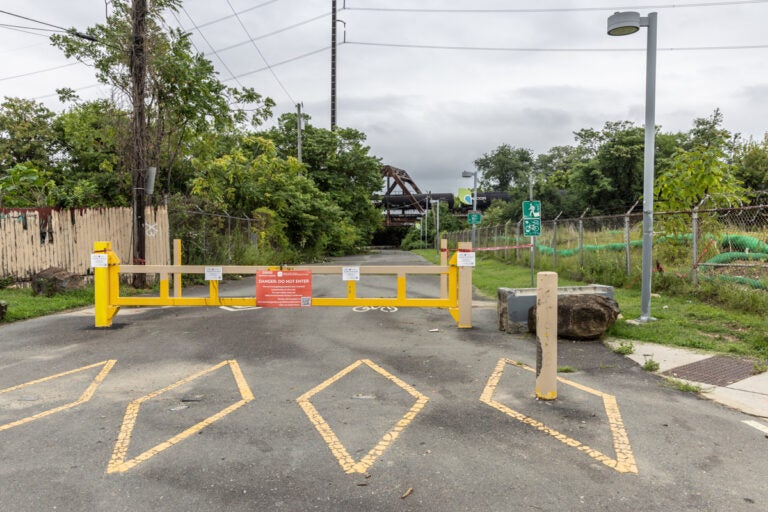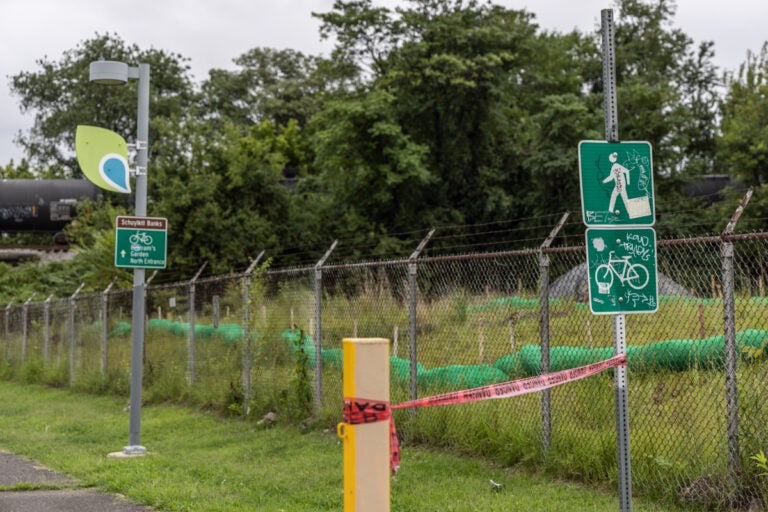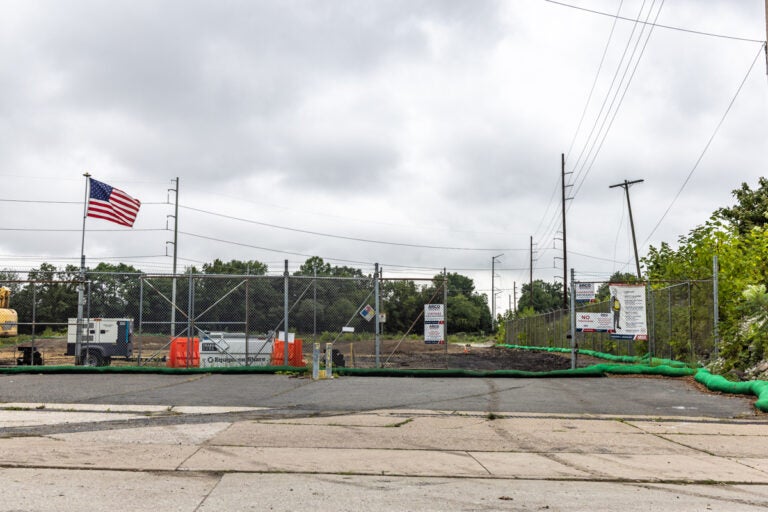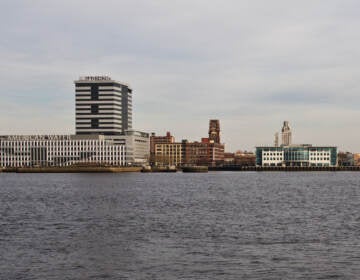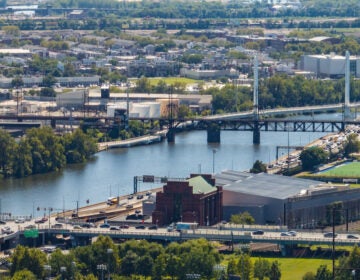What to know about the chemical contamination at Bartram’s Garden
A portion of trail remains closed after testing found small amounts of contamination on the property. Evidence shows similar contamination documented two years ago.
Listen 1:13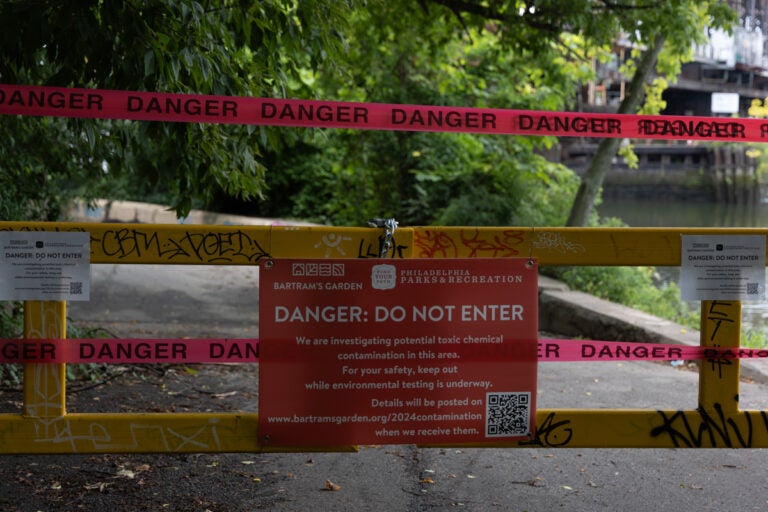
Part of the Bartram’s Garden hiking trail, closed due to possible contamination on August 7, 2024. (Kimberly Paynter/WHYY)
From Philly and the Pa. suburbs to South Jersey and Delaware, what would you like WHYY News to cover? Let us know!
What we know, and don’t know, about the Bartram’s Garden chemical spill
Correspondence from 2022 shows that a consultant working for the current owners of a former industrial site next to Bartram’s Gardens in Southwest Philadelphia discovered a mysterious yellow-green soil on the property. It’s unclear what became of that soil. Fast forward two years later, in April, a similar substance was spotted by a hiker along the Bartram’s Garden trail. But its origins remain a mystery.
The 500-foot section of the trail, near the entrance at 51st and Lindbergh Boulevard, has been closed since mid-July, and boating and fishing activities remain suspended after investigations determined a toxic chemical called hexavalent chromium leaked from the former industrial site.
“It was scary. I seen the red tape [blocking the entrance],” said Steven Allen, a regular visitor to the trail who recently was looking forward to an afternoon of fishing along the Schuylkill River.
He had to change his plans.
“I thought something bad happened out here, but now I’m reading the sign and seeing something about chemicals — and that ain’t good,” Allen said. “I have to find another spot to go to, and hopefully they could clean it up so everybody can just go out walking trails.”
State and city agencies said the spill doesn’t pose a serious threat to the general public. However, Bartram’s Garden staff last week said that their independent testing revealed remnants of the contamination remain on the property — and they don’t plan on reopening the trail until they’re sure the spill is under control.
When was the contamination first reported?
Andy Switzer said he was walking his dogs along the trail at Bartram’s Garden in April when he noticed a green substance on the nearby streambed.
On the advice of a friend, he reported the sighting to several agencies.
How did environmental regulators respond?
According to the DEP, agency staff visited the neighboring former industrial site April 12 and could not find any violations. Meanwhile, the Philadelphia Water Department tested the substance reported by Switzer. In May, PWD’s lab determined the presence of a synthetic, non-fluorescent dye.
Upon receiving the results, DEP inspected the site a second time. The agency determined the owners of the site were using berms to prevent stormwater from leaving the site. No violations were issued, but the agency requested the site owner investigate the source of the discolored discharge.
In June, results indicated the presence of excessive amounts of trivalent and hexavalent chromium. The site’s owners said they’ve agreed to remediate the spill.
What is hexavalent chromium?
According to the Occupational Safety and Health Administration, hexavalent chromium is known to cause cancer and targets the respiratory system, kidneys, liver, skin and eyes. The chemical is used in a number of industrial products including inks, paints, dyes, wood preservatives and metal finishing.
According to documents provided to WHYY, the site owner’s consultant wrote they were thrown “off track” by PWD’s initial information, because they were “looking for sources of synthetic dyes.” The consultant said PWD would not provide laboratory data.
After several weeks of back-and-forth with DEP, Switzer said he received the sample results.
By July, however, DEP had not notified Bartram’s Garden, or the public, about its investigation. Switzer said he believed the agency wasn’t taking the spill seriously enough, and notified Bartram’s staff. Bartram’s immediately reached out to city and state officials for more information, and closed the trail out of an abundance of caution.
DEP was criticized by some for a perceived lack of transparency. In a virtual meeting at the end of July, DEP said it did not immediately alert the public because the spill posed no serious threat.
DEP on Friday published information for community members concerned about the spill.
Are there any public health hazards?
There is no threat to public drinking water, according to the Philadelphia Water Department. Drinking water intakes are located much further upriver. The Philadelphia Fire Department’s Hazardous Materials Unit also inspected the trail and found no threats to air quality or toxic runoff.
Visitors walking, running or riding a bike on the trail through the area are at “very low risk” for exposure, environmental and health officials said. Exposure to chromium can be reduced by washing hands or exposed skin thoroughly with soap and water to remove soil residue.
While long-term chronic exposure to hexavalent chromium can be hazardous, it is unlikely that short-term exposure to chromium at low to moderate levels will result in severe health effects, officials said.
Why is the trail still closed?
Bartram’s Garden has conducted independent testing on its property. Results returned last week determined additional low levels of contamination elsewhere on the property, including in areas where equipment is stored.
Bartram’s staff want the property’s indoor spaces and equipment professionally cleaned before resuming biking and boating activities.
Prior to reopening the trail, Bartram’s staff say they need to feel assured there’s no recurring contamination, and that the chemicals have been contained.
“Particularly thinking about the safety of our staff who are planting or gardening in the area, who might be getting further down into the soil,” said spokeswoman Caroline Winschel.
“And, thinking about the programs that we have that go up and down the trail — just so that we’re making sure that once that’s open, that people don’t have to worry that they’re picking something up on their shoes, or their bicycle, that they would feel concerned about bringing home, or bringing into their personal space.”
Winschel said Bartram’s has not been in contact with the site’s owner. Bartram’s is waiting on DEP to answer additional questions about groundwater and soil safety, she said.
Were the site owners issued any violations?
On July 18, DEP issued the site owners three violations: failure to comply with DEP regulations or the Clean Streams Law; failure to take necessary measures to prevent pollutants from reaching waters of the commonwealth; and failure to implement and/or maintain E&S BMPs for earth disturbance.
According to the inspection report, there was a gap under the site’s filter sock (a type of barrier) where stormwater eroded the soils beneath, therefore “failing to fully function to filter stormwater.”
Sediment was carried off-site, across a paved trail and “deposited at an outlet in a curb leading directly to the Schuylkill River.” Inspectors also discovered a large trench on-site with steep slopes without a safety fence.
Several days later, the agency noted erosion and sediment control improvements.
On Aug. 8, DEP conducted an unannounced site inspection and cited the property owner for failure to stabilize the large stockpile of dirt on the site.
Kevin Feeley, a spokesman for the site owners, said the company has addressed the issues outlined in the inspection.
“We believe that we are having success in containing and addressing this problem. And our goal is to address it, ensure that it doesn’t happen again in the future,” he said. “These are guys who want to put the land back into productive use. They’re interested in doing whatever they have to do to ensure that the site is cleaned up, and in accordance with all environmental standards.”
What is the site’s history?
The site is a former petroleum tank farm that’s now enrolled in the voluntary Act Two brownfield cleanup program with the state.
Alliance 51st LLC purchased the property in 2021, and in 2022, agreed to remediate contamination associated with the former use of the property as a fuel oil terminal between 1951 and 2021 by Allied Oil, Hess Oil & Chemical, Plains Products Terminals and PBF Logistics.
Among the contaminants detected on the site were benzene, trimethylbenzene and lead. Alliance’s remediation plan includes capping the contamination, and the company plans to build a warehouse distribution center on the site.
What is Act Two?
Under the voluntary state program, site owners must study the extent of contamination, and propose a cleanup plan, which must be approved by the DEP. Alliance’s plan was approved in February. After the site owner completes the cleanup, it must send a report to the DEP proving it met Act Two standards.
Feeley said Alliance was not previously aware of chromium contamination on the site. Act Two does not require site owners to test for any specific contaminant, nor does the site have a history of chromium use, Feeley said.
“No one anticipated or found, to our knowledge, the chromium runoff until it was reported in April,” he said.
According to documents provided to WHYY, Alliance’s consultant informed a DEP staffer in 2022 of a “yellow-green” stain on the soil at the site. However, it’s unclear whether the stain was investigated further. Feeley could not answer questions about the stain mentioned in the letter.
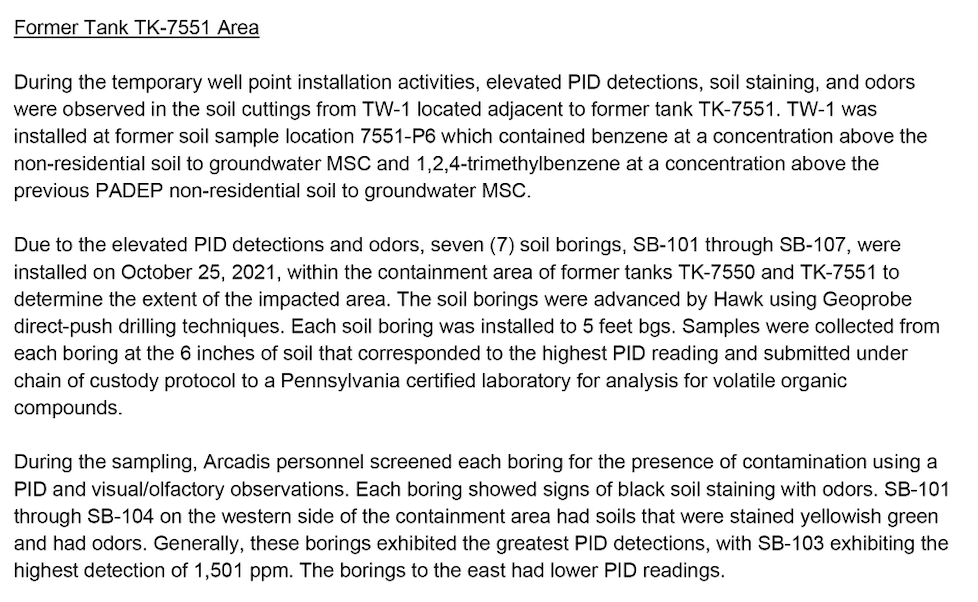
- A Pennsylvania Department of Environmental Protection document outlines the investigation into potential chromium compounds that leaked onto a portion of Bartram’s Mile Trail. (Pennsylvania Department of Environmental Protection)
While hexavalent chromium is used in paint coatings, including on storage tanks, the source of the contamination, and its origin, remains unknown.
Prior to the chromium spill, DEP approved a request from Alliance to move contaminated soil related to the Act Two cleanup, according to documents shared with WHYY. It is unclear whether activities associated with the cleanup unintentionally released chromium.
David Hess, a former DEP secretary who now publishes the PA Environmental Digest blog, told WHYY that understanding the source of contamination and its history would help determine the necessary paths forward.
Feeley said he could not answer whether the company was investigating the origin of the contamination or how it leaked.
Environmentalist Russell Zerbo of Clean Air Council said any planned warehouse development on the site should not begin until there’s a thorough investigation.
“They shouldn’t be allowed to develop while the cleanup is happening, and they should have to test for other contaminants that may be present,” he said.
Switzer also calls for the pause of construction until the source of contamination is determined.
“They seemed unconcerned with doing anything other than sticking to the plan they already have, which is to cap the site and build warehouses on it,” he said.

Get daily updates from WHYY News!
WHYY is your source for fact-based, in-depth journalism and information. As a nonprofit organization, we rely on financial support from readers like you. Please give today.



